Picture walking into your bedroom and feeling instant calm wash over you – no more cluttered corners or chaotic drawers stealing your peace. If you’re tired of the daily treasure hunt for matching socks or that favorite shirt, you’re not alone! I’ve discovered twelve game-changing organization tricks that’ll transform your bedroom from stressed to blessed. These aren’t just any tips – they’re the kind that’ll make you wonder why you didn’t try them sooner. Ready to see your space in a whole new light?
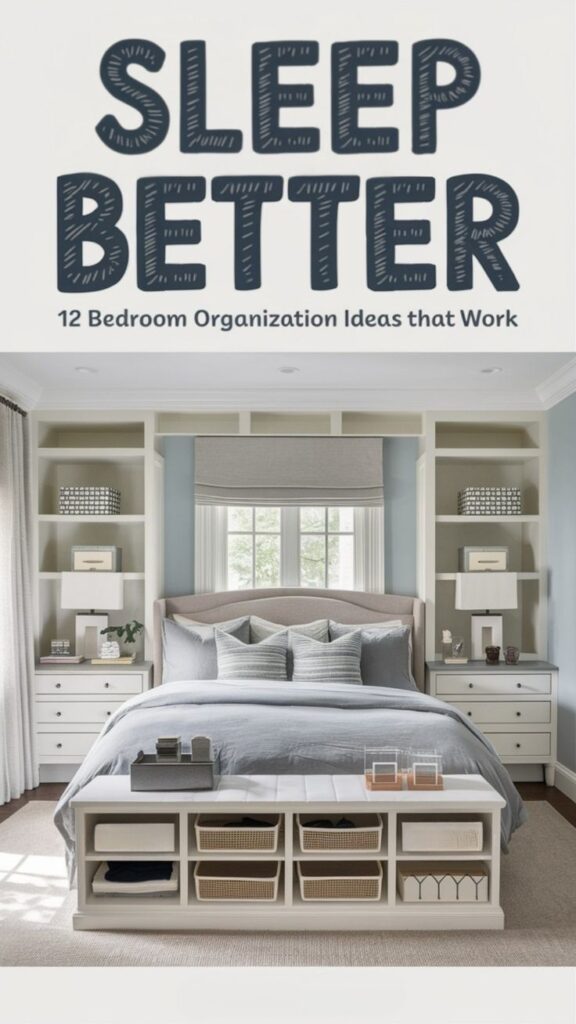
Start With a Clean Slate: Deep Clean Your Space

A deep clean of your bedroom creates the perfect foundation for any organization project. Starting with a thoroughly cleaned space allows you to properly assess your room’s layout, storage potential, and organizational needs without the distraction of dust, clutter, or dirt. This initial step is crucial as it sets the tone for maintaining an organized space long-term.
Working with a clean slate not only provides physical clarity but also offers mental clarity. The process of deep cleaning forces you to handle each item in your room, making it easier to decide what to keep, donate, or discard. This mindful approach to cleaning helps prevent the reintroduction of unnecessary items once you begin organizing.
Required Items:
- All-purpose cleaner
- Glass cleaner
- Microfiber cloths
- Vacuum cleaner
- Duster with extension
- Garbage bags
- Cleaning gloves
- Bucket
- Mop
- Laundry basket
- Storage boxes
The deep cleaning process should follow a top-to-bottom, left-to-right methodology. Start by removing all items from surfaces and storing them temporarily in another room. Dust ceiling corners, light fixtures, and fan blades first. Move to walls, windows, and mirrors, using appropriate cleaners for each surface.
Remove all furniture possible from the room and vacuum thoroughly, including under the bed and inside closets. Wipe down all furniture surfaces, including drawer interiors, before returning them to the room. Wash all bedding, including pillows and curtains, while cleaning the room. Finally, clean flooring appropriate to its material – vacuum carpets thoroughly or mop hard surfaces.
Additional Tips: Break the deep cleaning process into manageable sections if time is limited, but try to complete the entire room within 48 hours to maintain momentum. Keep windows open during cleaning for proper ventilation, and consider using natural cleaning products to avoid harsh chemical odors in your sleeping space.
Take photos of your clean room to serve as motivation for maintaining the space and as a reference point for future organization projects.
Master the Art of Closet Organization

A well-organized closet serves as the foundation for an efficient morning routine and a clutter-free bedroom. When clothes, accessories, and shoes each have their designated space, you eliminate the daily stress of searching for items and save valuable time that would otherwise be spent rummaging through disorganized piles.
Closet organization goes beyond simple tidiness – it’s about creating a functional system that works with your lifestyle and wardrobe needs. An organized closet helps you maintain a clear inventory of your clothing, prevent unnecessary purchases, and extend the life of your garments through proper storage and care.
Essential Tools and Items:
- Hangers (matching set)
- Storage bins or boxes
- Drawer organizers
- Shelf dividers
- Labels
- Measuring tape
- Shoe racks
- Belt/tie organizers
- Storage baskets
- Clothing rod dividers
Start by removing everything from your closet and sorting items into categories: keep, donate, repair, and discard. Measure your closet space and plan zones for different types of clothing. Install adjustable rods at varying heights to maximize vertical space – hang longer items like dresses and coats in areas with more clearance, while shorter items like shirts and skirts can be doubled up with an additional rod below.
Group similar items together and arrange them by color or season. Use higher shelves for out-of-season or rarely used items, and keep frequently worn pieces at eye level. Implement drawer organizers for smaller items like accessories, undergarments, and socks. Install hooks or specialized organizers for belts, scarves, and jewelry.
Additional organization success tips: Maintain the system by immediately returning items to their designated spots after use. Conduct seasonal reviews to reassess your organization needs and purge unnecessary items. Consider using space-saving hangers and storing off-season clothing in vacuum-sealed bags.
Install proper lighting to easily locate items and incorporate air fresheners or cedar blocks to keep clothes fresh and protected from moths.
Maximize Under-Bed Storage Solutions
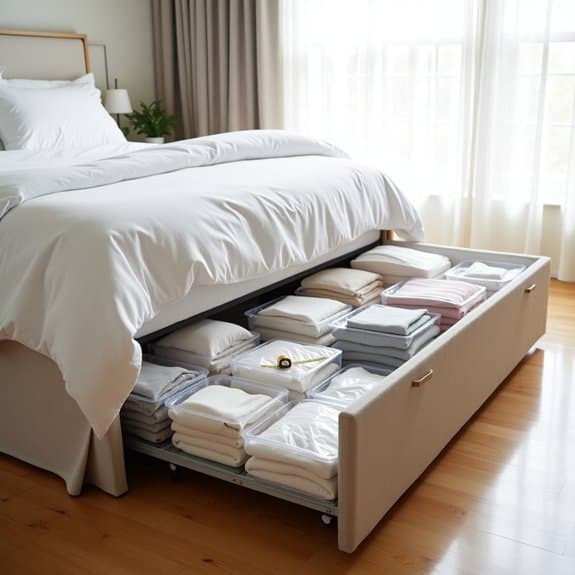
Making use of under-bed space is one of the most effective ways to expand storage capacity in any bedroom. This often-overlooked area can provide substantial square footage for storing seasonal items, extra bedding, clothing, and other belongings that aren’t needed daily.
Proper under-bed organization not only creates additional storage space but also protects items from dust and helps maintain a clutter-free bedroom environment. When items are properly contained and organized beneath the bed, they remain accessible while staying hidden from view, contributing to a more serene sleeping space.
Required Items:
- Under-bed storage containers or drawers
- Bed risers (if needed)
- Measuring tape
- Labels
- Vacuum storage bags
- Dust-proof covers
- Clear plastic bins
- Drawer dividers
- Rolling carts (optional)
Start by measuring the available space under your bed, including height, width, and depth. Choose appropriate storage containers that maximize the dimensions while allowing easy sliding in and out. Sort items by category – seasonal clothing, extra bedding, shoes, or memorabilia. Use vacuum storage bags for soft items like blankets and winter clothing to reduce bulk. Place frequently accessed items toward the front and seasonal items toward the back.
For optimal organization, create zones under the bed – perhaps designating the right side for clothing and the left for household items. Install wheel-equipped containers or drawers for smooth access, and always use clear containers or detailed labels to quickly identify contents.
Consider using bed risers to create additional height if needed, but ensure they’re properly secured for safety.
To maintain an effective under-bed storage system, conduct quarterly reviews of stored items, regularly vacuum the area to prevent dust accumulation, and use cedar blocks or lavender sachets to keep stored textiles fresh.
Consider creating a simple diagram showing where specific categories of items are stored to avoid having to pull everything out when searching for particular items.
Create a Functional Nightstand Setup
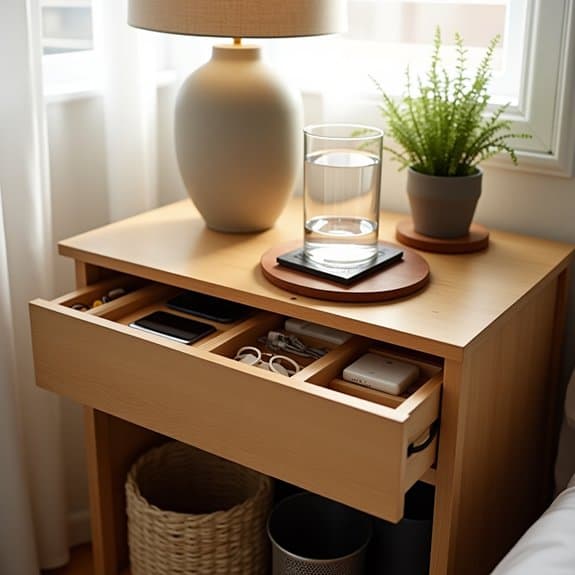
A well-organized nightstand serves as command central for your bedroom, keeping essential items within arm’s reach while maintaining a calm, clutter-free environment.
This small but crucial space impacts both the start and end of your day, from morning routines to nighttime rituals, making its organization vital for daily efficiency.
An optimized nightstand setup can reduce stress, save time, and improve sleep quality by eliminating the need to search for items in the dark or get up unnecessarily.
The key is to balance functionality with aesthetics, ensuring everything you need is accessible without creating visual chaos in your sleeping space.
Required Items:
- Drawer organizers or small containers
- Cable management solutions
- Bedside lamp
- Coasters
- Small trash bin
- Drawer liners
- Disinfecting wipes
- Storage boxes or baskets
- Multi-plug outlet adapter
- Declutter box
Start by completely clearing the nightstand surface and drawers, wiping everything down with disinfecting wipes.
Sort items into categories: daily essentials, occasional use, and items that belong elsewhere.
Install drawer liners to protect the surface and prevent items from sliding around.
Use drawer organizers to create designated spaces for small items like medications, reading glasses, or charging cables.
Arrange items on the surface by frequency of use, keeping daily essentials closest to the bed.
Position your lamp at the back corner, leaving space for a water glass on a coaster.
Install a multi-plug adapter for charging devices, using cable management solutions to prevent cord tangles.
Place a small trash bin nearby for convenience.
Organization maintenance is crucial for long-term success.
Implement a weekly cleaning routine, wiping down surfaces and reviewing contents.
Consider using the “one in, one out” rule when adding new items to prevent clutter accumulation.
Keep seasonal items in storage boxes that can be rotated as needed, and regularly assess whether items still serve a purpose in your nighttime routine.
Install Smart Vertical Storage Systems
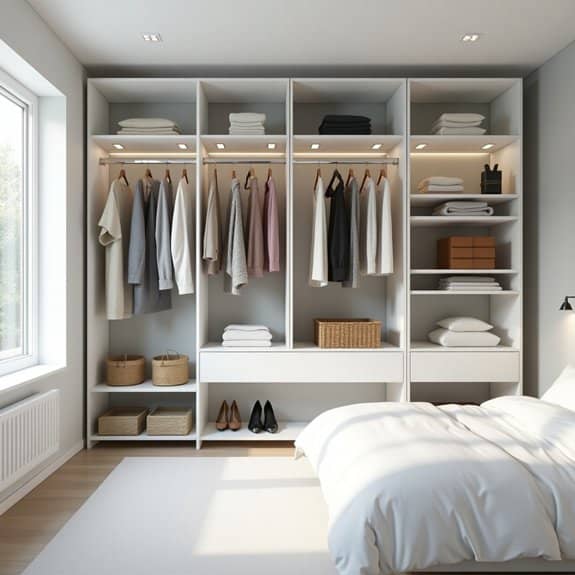
Vertical storage systems are essential in modern bedrooms where floor space is often limited. By utilizing wall space effectively, you can maximize storage capacity while maintaining a clean, uncluttered aesthetic that promotes relaxation and peace of mind.
Installing smart vertical storage solutions transforms unused wall areas into functional storage spaces, creating organized zones for clothing, accessories, books, and personal items. This approach not only saves valuable floor space but also makes items more accessible and visible, reducing the time spent searching for belongings.
Required Items:
- Wall mounting brackets
- Screws and wall anchors
- Drill and drill bits
- Level
- Measuring tape
- Pencil
- Adjustable shelving units
- Over-door organizers
- Wall-mounted hooks
- Hanging storage bins
- Screwdriver
- Stud finder
Start by measuring your wall space and marking potential mounting locations, using a stud finder to locate secure attachment points. Install the main mounting brackets according to manufacturer specifications, ensuring they’re perfectly level.
Begin with the highest points first, working your way down systematically. Position adjustable shelving units, ensuring adequate spacing between levels for different item heights.
For clothing storage, install closet rods or hanging organizers between vertical supports. Add specialized storage solutions such as pull-out baskets, drawer units, or shoe racks based on your specific needs.
Consider incorporating modular components that can be easily reconfigured as storage needs change.
To maximize your vertical storage system, organize items by frequency of use, keeping frequently accessed items at eye level and seasonal items higher up or lower down. Use clear storage containers to maintain visibility, and label everything clearly.
Consider adding LED strip lighting to illuminate darker corners and make items easier to locate. Regular maintenance of the system, including tightening screws and checking weight limits, will ensure long-term functionality and safety.
Declutter Your Dresser Drawers

A cluttered dresser drawer can turn the simple task of finding clothes into a frustrating ordeal. When drawers are disorganized, clothes become wrinkled, damaged, and often forgotten, leading to unnecessary purchases and wasted space. Proper drawer organization is a fundamental step in creating an efficient bedroom storage system.
Taking control of dresser drawer chaos not only saves time during daily routines but also extends the life of your clothing. An organized drawer system allows you to see everything you own at a glance, making outfit selection easier and helping you maintain a better inventory of your wardrobe.
Required Items:
- Drawer dividers
- Folding board
- Storage boxes or bins
- Labels
- Measuring tape
- Donation bag
- Lint roller
- Clean microfiber cloth
Start by removing everything from your drawers and sorting items into three piles: keep, donate, and discard. Clean the empty drawers thoroughly with a microfiber cloth. Measure your drawers and plan your organization system using appropriate-sized dividers and storage boxes.
Group similar items together (socks with socks, underwear with underwear) and implement the file folding method, which allows you to see all items at once when you open the drawer. For optimal organization, assign specific drawers for different categories of clothing. Place frequently used items in the most accessible drawers.
Use drawer dividers to create designated spaces for each category, preventing items from mixing and shifting. Fold clothes uniformly using a folding board to maintain consistency and maximize space.
For long-term success, maintain the system by putting clothes away immediately after laundering and doing quick weekly touch-ups. Consider implementing a one-in-one-out rule to prevent overflow, and reassess your drawer organization every season when switching out clothing.
Store off-season items in separate storage containers to free up valuable drawer space.
Set Up a Designated Laundry System

A well-organized laundry system in the bedroom is essential for maintaining cleanliness and order while preventing dirty clothes from accumulating on floors or furniture. When clothes have a designated place, it becomes easier to maintain a regular laundry schedule and keep track of what needs washing.
An efficient laundry system saves time, reduces stress, and helps protect your clothing investment by ensuring proper sorting and care. It also prevents clean and dirty clothes from mixing, which can lead to confusion and unnecessary rewashing of items.
Required Items:
- Hamper or multiple sorting bins
- Mesh laundry bags
- Labels or markers
- Storage baskets
- Hangers
- Over-the-door hooks
- Collapsible drying rack
- Small containers for detergent pods/supplies
- Lingerie bags
- Stain removal supplies
Start by selecting a dedicated corner or area in your bedroom for the laundry system. Position multiple sorting bins or a sectioned hamper for pre-sorting clothes into categories: whites, darks, delicates, and heavily soiled items.
Install hooks or a small rod nearby for hanging items that need air drying or special care. Place mesh bags within easy reach for delicate items and create a small station for stain treatment supplies.
Establish a workflow by arranging the components in a logical sequence. Keep clean laundry supplies separate from dirty laundry areas. Set up a folding station nearby, whether it’s a clear space on top of a dresser or a dedicated table.
Consider vertical storage solutions if space is limited, such as stacking bins or over-the-door organizers.
Additional Tips: Implement a regular schedule for laundry days and stick to it. Consider using color-coded bins or labels to make sorting easier for family members.
Keep a small basket for items requiring repairs or special cleaning, and address these regularly to prevent buildup. Remember to periodically clean and disinfect your laundry bins and storage areas to maintain hygiene.
Organize Accessories and Jewelry
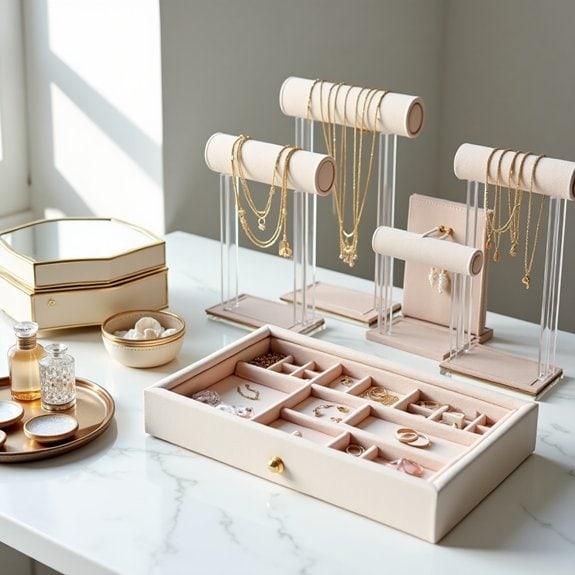
Organizing accessories and jewelry is crucial for protecting valuable pieces while ensuring easy access to your favorite items. A well-organized jewelry collection prevents tangling, damage, and the frustration of searching through jumbled items when getting ready for the day or a special event.
Creating a dedicated space for accessories and jewelry not only preserves their condition but also allows you to see your entire collection at a glance, making outfit coordination simpler and helping you rotate through your pieces more effectively. This organization system can also help identify gaps in your collection and prevent unnecessary duplicate purchases.
Required Items:
- Jewelry box or organizer
- Drawer dividers
- Ring holders
- Necklace stands
- Small fabric pouches
- Hooks or pegboard
- Clear containers
- Soft cloth or felt
- Labels
- Anti-tarnish strips
Start by sorting all accessories and jewelry into categories: necklaces, bracelets, rings, earrings, watches, and other accessories. Remove any damaged, tarnished, or unwanted pieces. Clean all items before organizing.
Install appropriate storage solutions based on your space – whether it’s a drawer system, hanging organizer, or dedicated jewelry box. Position necklaces on individual hooks to prevent tangling, and use compartmentalized storage for smaller items like earrings and rings.
For frequently worn pieces, create an easily accessible everyday section. Store special occasion jewelry in protective pouches or boxes. Consider using clear containers to maintain visibility while protecting items from dust. If using a drawer system, line compartments with felt to prevent scratching and sliding.
Additional Tips: Incorporate moisture-absorbing silica gel packets in storage areas to prevent tarnishing, and keep photograph records of valuable pieces for insurance purposes. Regular maintenance of your organization system, including monthly decluttering and cleaning, will help maintain order and extend the life of your accessories.
Consider rotating seasonal pieces to the front of your storage system for easier access during appropriate times of the year.
Utilize Door and Wall Space Effectively
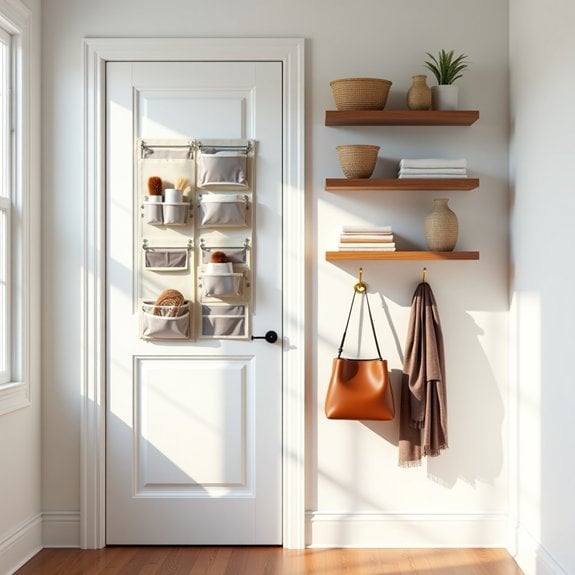
Making the most of vertical space in your bedroom is crucial for maximizing storage and maintaining a clutter-free environment. Doors and walls represent significant unused real estate in most bedrooms, offering countless opportunities for smart storage solutions and organization.
By strategically utilizing these often-overlooked spaces, you can free up valuable floor space while keeping essential items easily accessible. Proper door and wall organization can transform a cramped bedroom into an efficiently organized space that promotes relaxation and functionality.
Required Items:
- Over-the-door hooks
- Over-the-door organizers
- Wall-mounted shelves
- Command hooks
- Wall-mounted storage baskets
- Picture hanging hardware
- Stud finder
- Level
- Drill and screws
- Measuring tape
- Pencil
Start by assessing your doors and walls for suitable mounting locations, using a stud finder to mark stable mounting points. Install over-the-door hooks or organizers on bedroom and closet doors, ensuring they’re properly secured.
For walls, mount shelves at varying heights, keeping frequently used items at eye level and seasonal items higher up. Create designated zones for different categories – accessories near the dresser, reading materials near the bed, and frequently used items near the door. Install hooks or pegboards for hanging items like scarves, jewelry, or bags in easily accessible locations.
Additional Success Tips:
Consider weight limits when mounting items, and always use appropriate anchors for heavy objects. Rotate seasonal items to maintain organization and prevent overcrowding.
Label storage containers and zones to maintain system integrity, and periodically reassess your organization needs as seasons and storage requirements change. Remember to leave some wall space clear to prevent visual clutter and maintain a peaceful bedroom atmosphere.
Implement the One-In-One-Out Rule
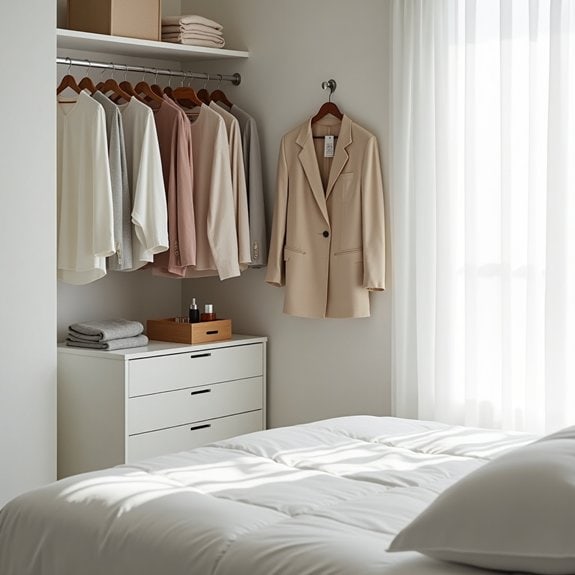
The One-In-One-Out Rule stands as a fundamental principle in maintaining an organized and clutter-free bedroom environment. This simple yet powerful approach prevents the gradual accumulation of items that often leads to overcrowded spaces, making it increasingly difficult to maintain order and find what you need.
By establishing this systematic approach to managing your belongings, you create a sustainable method for keeping your bedroom’s contents in check. The rule operates on a balanced exchange system – when a new item enters your bedroom space, an existing item must leave, ensuring your space remains consistently organized and preventing the slow creep of clutter that can overwhelm your living area.
Required Items:
- Donation box or bag
- Trash bags
- Storage containers
- Labels
- Notebook for inventory
- Calendar or reminder system
- Storage bins for seasonal rotation
The implementation process begins with a thorough inventory of your current belongings, categorizing items by type and frequency of use. When purchasing a new item, immediately identify its designated category and select an existing item from the same category to remove. For clothing, this might mean donating an old shirt when buying a new one. For books, remove an existing volume when adding another to your collection.
Create a designated “outgoing” space in your bedroom where items slated for removal can be temporarily stored until you’re ready to donate, sell, or dispose of them. Maintain explicit rules about exceptions to prevent the system from breaking down. Consider implementing quarterly reviews of your belongings to ensure compliance with the rule and address any areas where items have accumulated.
Document your decisions in a simple log to track patterns in your purchasing and disposal habits, helping you make more mindful acquisition choices in the future. To maximize success, establish a regular schedule for processing outgoing items, whether weekly or monthly, to prevent the accumulation of items marked for removal.
Consider photographing items before removal if you’re hesitant about letting go, and partner with a friend or family member who can help hold you accountable to the system. Remember that seasonal items can operate on a rotation system rather than permanent removal, but must still adhere to strict one-in-one-out parameters within their category.
Design a Practical Shoe Storage Solution
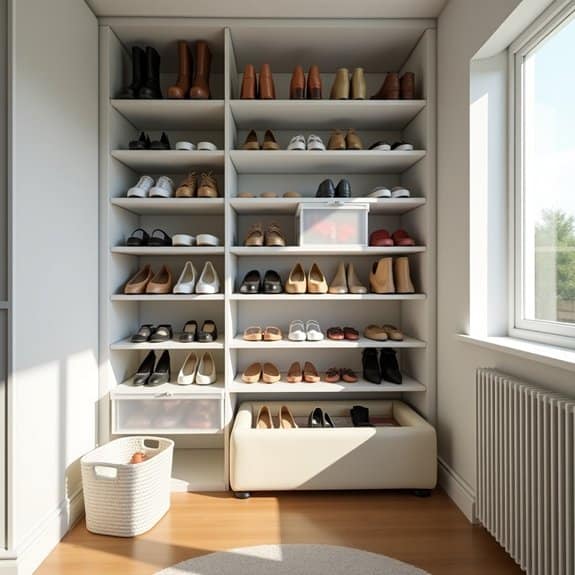
Proper shoe storage is essential for maintaining an organized bedroom and protecting your footwear investment. When shoes are scattered across the floor, they not only create visual clutter but also become susceptible to damage, dust accumulation, and can create tripping hazards in your personal space.
A well-designed shoe storage solution can transform your bedroom’s functionality while extending the life of your shoes. By implementing an effective storage system, you’ll save time getting ready, maintain better air circulation around your footwear, and create a more streamlined appearance in your bedroom space.
Required Items:
- Shoe rack or shelving unit
- Clear plastic shoe boxes
- Storage bench (optional)
- Over-the-door organizer
- Label maker or tags
- Measuring tape
- Dehumidifier sachets
- Dust bags for delicate shoes
- Drawer dividers
- Cleaning supplies
Start by assessing your shoe collection and categorizing footwear by type, frequency of use, and season. Remove any shoes that are damaged beyond repair or haven’t been worn in the past year.
Measure your available space carefully, considering vertical storage options if floor space is limited. Install your chosen storage solution, whether it’s a dedicated shoe rack, built-in shelving, or over-the-door organizer, ensuring it’s sturdy and level.
For special occasion shoes or seasonal items, use clear plastic boxes to protect them from dust while keeping them visible. Place frequently worn shoes in easily accessible locations, while storing occasional-use footwear in higher or less accessible spaces.
For optimal organization maintenance, implement a one-in-one-out rule when purchasing new shoes, regularly clean both your shoes and storage areas, and use dehumidifier sachets to prevent moisture damage.
Consider keeping a small basket near your shoe storage for items that need cleaning or repair, and rotate seasonal footwear to maximize space usage throughout the year. Remember to periodically reassess your storage needs as your collection changes or grows.
Establish Daily Tidying Habits
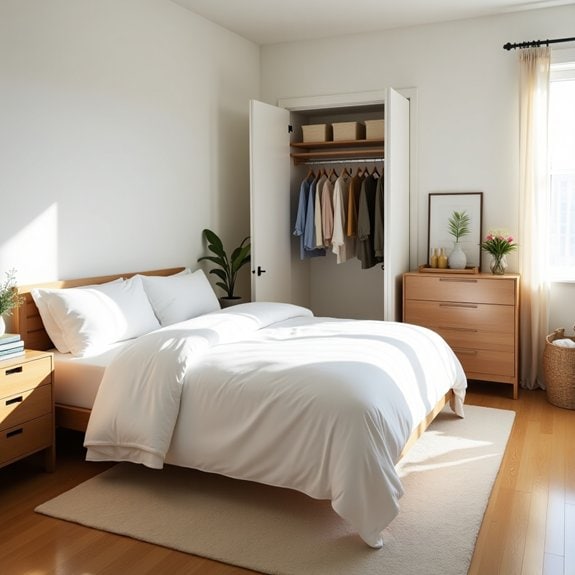
Maintaining a tidy bedroom through daily habits is essential for creating a peaceful, stress-free environment. When clutter accumulates, it can affect sleep quality, increase anxiety, and make it difficult to locate important items when needed. A consistently organized bedroom serves as a sanctuary and promotes better mental well-being.
Establishing daily tidying habits transforms bedroom maintenance from an overwhelming task into manageable, quick actions. These small, consistent efforts prevent the need for major cleaning sessions and help maintain the room’s functionality and aesthetic appeal throughout the week, saving time and energy in the long run.
Required Items:
- Laundry hamper
- Storage bins
- Drawer organizers
- Small trash bin
- Closet hangers
- Bedding
- Cleaning supplies
- Storage boxes
- Catch-all tray
- Timer or clock
Start each morning by making your bed immediately after waking up. This simple act sets a productive tone for the day and instantly makes the room look tidier. Follow this by placing any dirty clothes in the hamper and returning clean clothes to their designated spots in drawers or closets. Before leaving the room, spend two minutes clearing surfaces of any items that don’t belong, placing them in their proper locations.
In the evening, implement a “ten-minute tidy” routine. Put away items used during the day, including accessories, electronics, and clothing. Clear nightstands of unnecessary items, leaving only essentials for the next morning. Quickly dust visible surfaces and ensure pathways remain clear for safety during nighttime.
To maximize the effectiveness of daily tidying habits, set specific times for these activities and stick to them religiously. Consider using a checklist for the first few weeks until the habits become automatic. Breaking tasks into smaller, manageable actions makes them less daunting and more likely to become permanent habits.
Remember that consistency, rather than perfection, is the key to maintaining an organized bedroom long-term.


